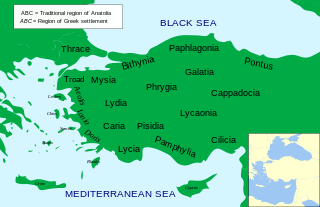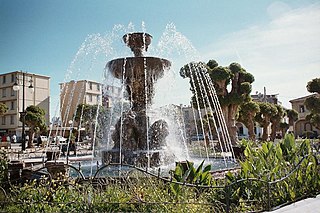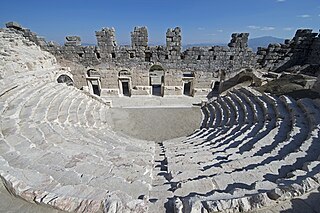Caesarea, a city name derived from the Roman title "Caesar", was the name of numerous cities and locations in the Roman Empire:
Caesarea, a city name derived from the Roman title "Caesar", was the name of numerous cities and locations in the Roman Empire:

Bithynia was an ancient region, kingdom and Roman province in the northwest of Asia Minor, adjoining the Sea of Marmara, the Bosporus, and the Black Sea. It bordered Mysia to the southwest, Paphlagonia to the northeast along the Pontic coast, and Phrygia to the southeast towards the interior of Asia Minor.

Caesarea, also Caesarea Maritima, Caesarea Palaestinae or Caesarea Stratonis, was an ancient and medieval port city on the coast of the Eastern Mediterranean, and later a small fishing village. It was the capital of Roman Judaea, Syria Palaestina and Palaestina Prima, successively, for a period of c.650 years, and a major intellectual hub of the Mediterranean, from the time of Herod I until the Muslim conquest of the Levant. Today, the site is part of the Caesarea National Park, on the western edge of the Sharon plain in Israel.

Paphlagonia was an ancient region on the Black Sea coast of north-central Anatolia, situated between Bithynia to the west and Pontus to the east, and separated from Phrygia by a prolongation to the east of the Bithynian Olympus. According to Strabo, the river Parthenius formed the western limit of the region, and it was bounded on the east by the Halys River. Paphlagonia was said to be named after Paphlagon, a son of the mythical Phineus.

Apollonia, known in the Early Islamic period as Arsuf and in the Crusader Kingdom of Jerusalem as Arsur, was an ancient city on the Mediterranean coast of today's Israel. In Israeli archaeology it is known as Tel Arshaf. Founded by the Phoenicians during the Persian period in the late sixth century BCE, it was inhabited continuously until the Crusader period, through the Hellenistic, Roman, and Byzantine periods, during the latter being renamed to Sozusa. It was situated on a sandy area ending towards the sea with a cliff, about 34 kilometres (21 mi) south of Caesarea.

Syria Palaestina, or Roman Palestine, was a Roman province in the Palestine region between the early 2nd and late 4th centuries AD. The provincial capital was Caesarea Maritima.

Bolu Province is a province situated in north-western Turkey. It is located between the capital, Ankara, and the largest city in the country, Istanbul. Its area is 8,313 km2, and its population is 320,824 (2022). The capital city of the province is Bolu.
Hadrianopolis or Adrianopolis may refer to several cities named after Hadrian:

Mauretania Caesariensis was a Roman province located in what is now Algeria. The full name refers to its capital Caesarea Mauretaniae.

Judaea was a Roman province from 6 to 132 CE, which incorporated the Levantine regions of Judea, Samaria and Idumea, extending over parts of the former regions of the Hasmonean and Herodian kingdoms of Judea. The name Judaea was derived from the Iron Age Kingdom of Judah.

Cherchell is a town on Algeria's Mediterranean coast, 89 kilometers (55 mi) west of Algiers. It is the seat of Cherchell District in Tipaza Province. Under the names Iol and Caesarea, it was formerly a Roman colony and the capital of the kingdoms of Numidia and Mauretania.

Caesarea, also transliterated as Keisarya or Qaysaria, is an affluent resort town in north-central Israel, which was named after the ancient city of Caesarea Maritima situated 1–2 kilometres (0.62–1.24 mi) to the south in the adjacent Caesarea National Park.
Tium was an ancient settlement, also known as Filyos, on the south coast of the Black Sea at the mouth of the river Billaeus in present-day Turkey. Ancient writers variously assigned it to ancient Paphlagonia or Bithynia.
Eupatoria and Magnopolis, or Eupatoria Magnopolis, was a Hellenistic city in the Kingdom of Pontus. The city was founded by Mithridates VI Eupator just south of where the Lycus flows into the Iris, the west end of the fertile valley of Phanaroea, probably in or near the village of Çevresu, Erbaa district, Tokat Province.

Caesarea in Mauretania was a Roman colony in Roman-Berber North Africa. It was the capital of Mauretania Caesariensis and is now called Cherchell, in modern Algeria. In the present time Caesarea is used as a titular see for Catholic and Eastern Orthodox bishops.

Cibyra or Kibyra, also referred to as Cibyra Magna, was an Ancient Greek city near the modern town of Gölhisar, in Burdur Province. It lay outside the north-western limits of the ancient province of Lycia and was the chief city of an independent state known as Cibyratis. Since 2016 it has been included in the Tentative list of World Heritage Sites in Turkey.
Hadrianopolis in Paphlagonia was a city in southwestern Paphlagonia, Asia Minor, about 3km west of modern Eskipazar.
Timonitis was a district in the interior of ancient Paphlagonia, near the borders of Bithynia. Pliny the Elder mentions its inhabitants under the name of Timoniacenses. Stephanus of Byzantium reports a fort of Paphlagonia named Timonium or Timonion (Τιμώνιον), from which the district no doubt derived its name.